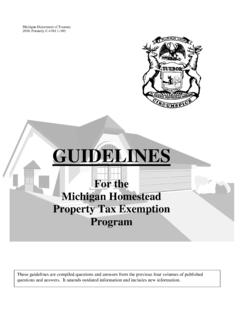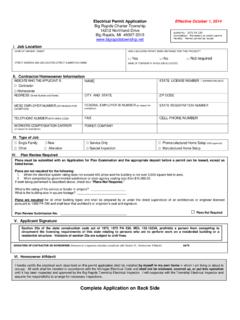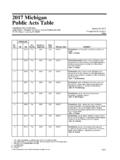Transcription of MI UNIFORM ENERGY CODE Apr 2011 - Big Rapids …
1 - 1 - michigan UNIFORM ENERGY code RESIDENTIAL ENERGY EFFICIENCY (PRESCRIPTIVE) MAJOR POINTS Attic & crawl access doors. Gasketed & with same R-value as assembly requirement. Floors. Insulation shall be installed to maintain permanent contact with underside of subfloor decking. Basement walls. Insulated from top of wall to floor, or can do floor above for unconditioned space. Slab on grade. From top of slab downward and/or horizontal 4 below grade. Can be mitered 45 at top. Table INSULATION AND FENESTRATION REQUIREMENTS BY COMPONENTS CLIMATE ZONE FENESTRATION U-FACTOR SKYLIGHTa U-FACTOR CEILING R-VALUE WOOD FRAME WALL R-VALUE MASS WALL R-VALUEf FLOOR R-VALUE BASEMENTb WALL R-VALUE SLABc R-VALUE & DEPTH CRAWL SPACEc WALL R-VALUE 6A 49 20 or 13+5e 15/19 30d 15/19 10, 4 ft 10/13 + 24 For SI: 1 foot = mm.
2 A. The fenestration U-factor column excludes skylights. b. The first R-value applies to continuous insulation, for the second to framing cavity insulation; either insulation meets the requirement. c. R-5 shall be added to the required slab edge R-values for heated slabs. Insulation depth shall be the depth of the footing or 2 feet, whichever is less, in zones 1-3 for heated slabs. d. Or insulation sufficient to fill the framing cavity, R-19 minimum. e. 13+5 means R-13 cavity insulation plus R-5 insulated sheathing. If structural sheathing covers 25% or less of the exterior, R-5 sheathing is not required where structural sheathing is used. If structural sheathing covers more than 25% of exterior, structural sheathing shall be supplemented with insulated sheathing of at least R-2.
3 F. The second R-value applies when more than half the insulation is on the interior. Ceilings with attic space. Can use R-38 in entire ceiling with R-38 ENERGY heel trusses. Crawl space walls. Can be insulated in lieu of floor for conditioned space; from floor to grade then additional 24 horizontal or vertical. Ground must be covered with a class 1 vapor retarder with joints over-lapped 6 and sealed and 6 up and sealed to walls. Replacement fenestration. Must comply with Building thermal envelope. The building thermal envelope shall be durably sealed to limit infiltration. The sealing methods between dissimilar materials shall allow for differential expansion and contraction. The following shall be caulked, gasketed, weatherstripped or otherwise sealed with an air barrier material, suitable film or solid material: 1.
4 All joints, seams and penetrations. 2. Site-built windows, doors or skylights. 3. Openings between window and door assemblies and their respective jambs and framing. 4. Utility penetrations. 5. Dropped ceilings or chases adjacent to the thermal envelope. 6. Knee walls. 7. Walls and ceilings separating a garage from conditioned spaces. 8. Behind tubs and showers on exterior walls. 9. Common walls between dwelling units. 10. Attic access openings. 11. Rim joist junction. 12. Other sources of infiltration. Certificate. A permanent certificate shall be posted on or in the electrical distribution panel, and shall meet all of the following: a) Be affixed or attached so it does not cover or obstruct the visibility of the circuit directory label, service disconnect label, or other required labels.
5 B) Be completed by the builder or registered design professional. c) List the predominant R-values of insulation installed in or on ceiling/roof, walls, foundation (slab, basement wall, crawlspace wall and/or floor) and ducts outside conditioned spaces and U-factors for fenestration. If there is more than 1 value for each component, then the certificate shall list the value covering the largest area. d) List the types and efficiencies of heating, cooling, and service water heating equipment. e) If a gas-fired unvented room heater, electric furnace, or baseboard electric heater is installed in the residence, then the certificate shall list gas-fired unvented room heater, as appropriate. An efficiency shall not be listed for gas-fired unvented room heaters, electric furnaces, or electric baseboard heaters.
6 2 Information on construction documents. Construction documents shall be drawn to scale upon suitable material. Electronic media documents are permitted to be submitted when approved by the code official. Construction documents shall be of sufficient clarity to indicate the location, nature and extent of the work proposed, and show in sufficient detail pertinent data and features of the building, systems and equipment as herein governed. Details shall include, but are not limited to, as applicable, insulation materials and their R-values; fenestration U-factors and SHGCs; area-weighted U-factor and SHGC calculations; mechanical system design criteria; mechanical and service water heating system and equipment types, sizes and efficiencies; economizer description; equipment and system controls; fan motor horsepower (hp) and controls; duct sealing, duct and pipe insulation and location; lighting fixture schedule with wattage and control narrative; and air sealing details.
7 Required approvals. Work shall not be done beyond the point indicated in each successive inspection without first obtaining the approval of the code official. Inspection requirements. It shall be the duty of the holder of the permit or their duly authorized agent to notify the code official when work is ready for inspection. It shall be the duty of the permit holder to provide access to and means for inspections of such work that are required by this code . Revocation. The code official is authorized to, in writing, suspend or revoke a notice of approval issued under the provisions of this code wherever the certificate is issued in error, or on the basis of incorrect information supplied, or where it is determined that the building or structure, premise, or portion thereof is in violation of any ordinance or regulation or any of the provisions of this code .
8 Fenestration products shall be labeled and certified. Exterior foundation insulation must be protected. Maintenance instructions for mechanical equipment shall be clearly labeled. Recessed lighting. When installed in the building thermal envelope, recessed lighting fixtures shall meet 1 of the following requirements: a) Type IC rated, manufactured with no penetrations between the inside of the recessed fixture and ceiling cavity and sealed or gasketed to prevent air leakage into the unconditioned space. b) Type IC or non-IC rated, installed inside a sealed box constructed from a minimum ( mm) gypsum wallboard or constructed from a pre-formed polymeric vapor barrier, or other air-tight assembly manufactured for this purpose, while maintaining required clearances of not less than inch ( mm) from combustible material and not less than 3 inches (76 mm) from insulation material.
9 C) Type IC rated and admitting not more than cubic feet per minute (cfm) ( L/s) of air movement from the conditioned space to ceiling cavity when tested in accordance with ASTM E 283. The lighting fixture shall be tested at psi (75 Pa) pressure difference and shall be labeled. Programmable thermostat. Where the primary heating system is a forced-air furnace, at least one thermostat per dwelling unit shall be capable of controlling the heating and cooling system on a daily schedule to maintain different temperature set points at different times of the day. This thermostat shall include the capability to set back or temporarily operate the system to maintain zone temperatures down to 55 F (13 C) or up to 85 F (29 C). The thermostat shall initially be programmed with a heating temperature set point no higher than 70 F (21 C) and a cooling temperature set point no lower than 78 F (26 C).
10 Heat pump supplementary heat (Mandatory). Heat pumps having supplementary electric-resistance heat shall have controls that, except during defrost, prevent supplemental heat operation when the heat pump compressor can meet the heating load. Insulation (Prescriptive). Supply ducts in attics shall be insulated to a minimum of R-8. All other ducts shall be insulated to a minimum of R-6. Exception: Ducts or portions thereof located completely inside the building thermal envelope. Sealing (Mandatory). All ducts, air handlers, filter boxes, and building cavities used as ducts shall be sealed. Joints and seams shall comply with section of the michigan residential code . Building cavities (Mandatory). Building framing cavities shall not be used as supply ducts.


